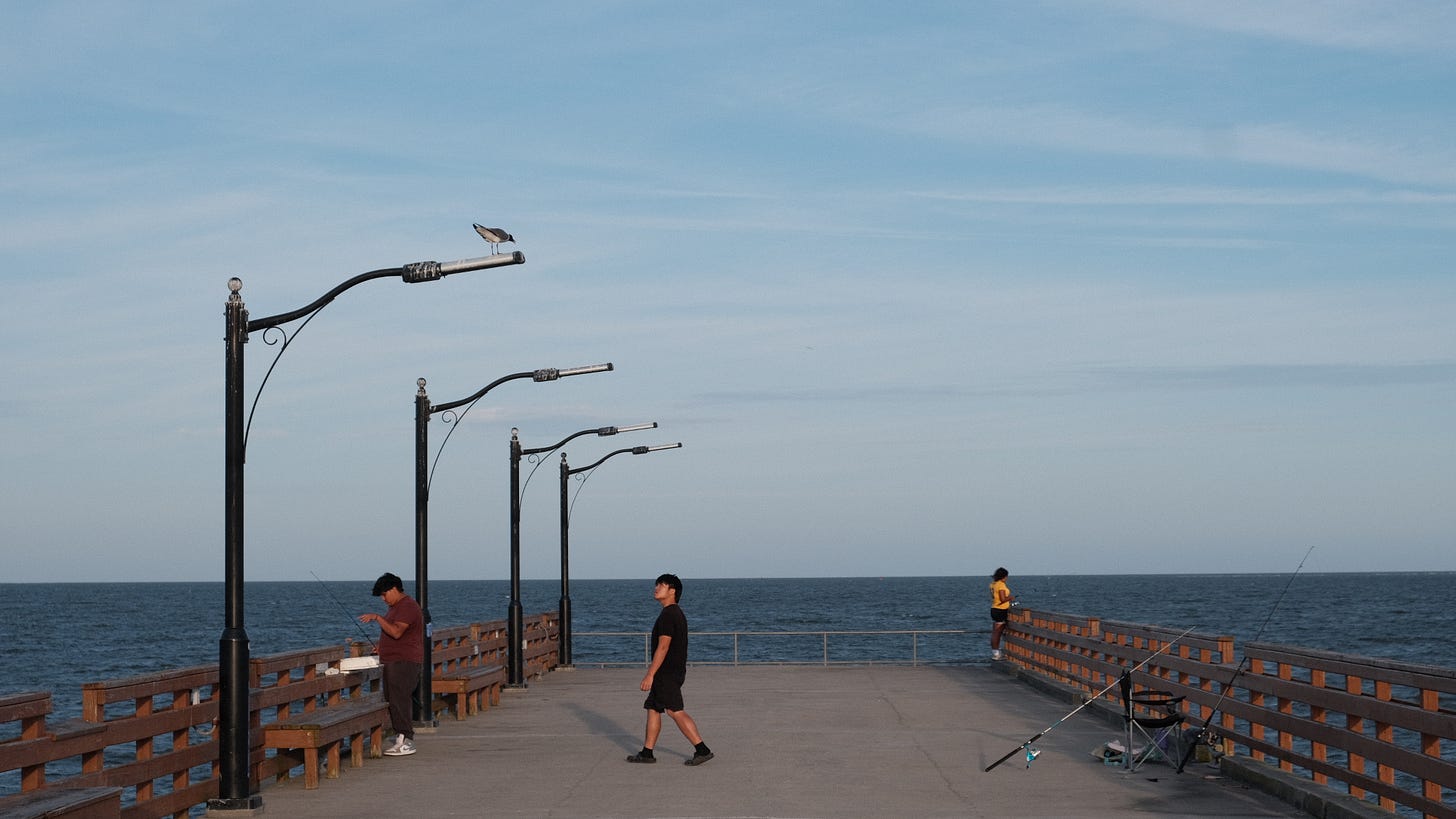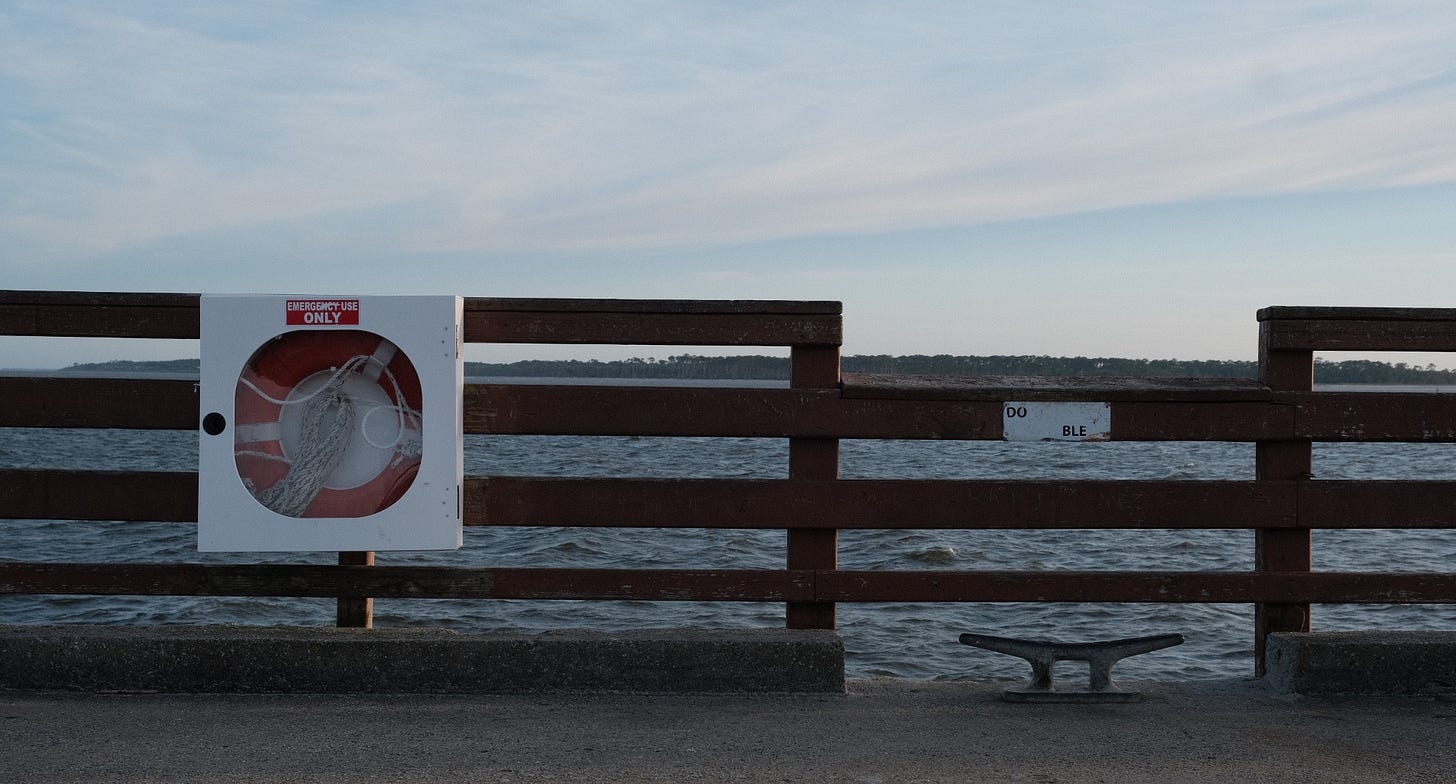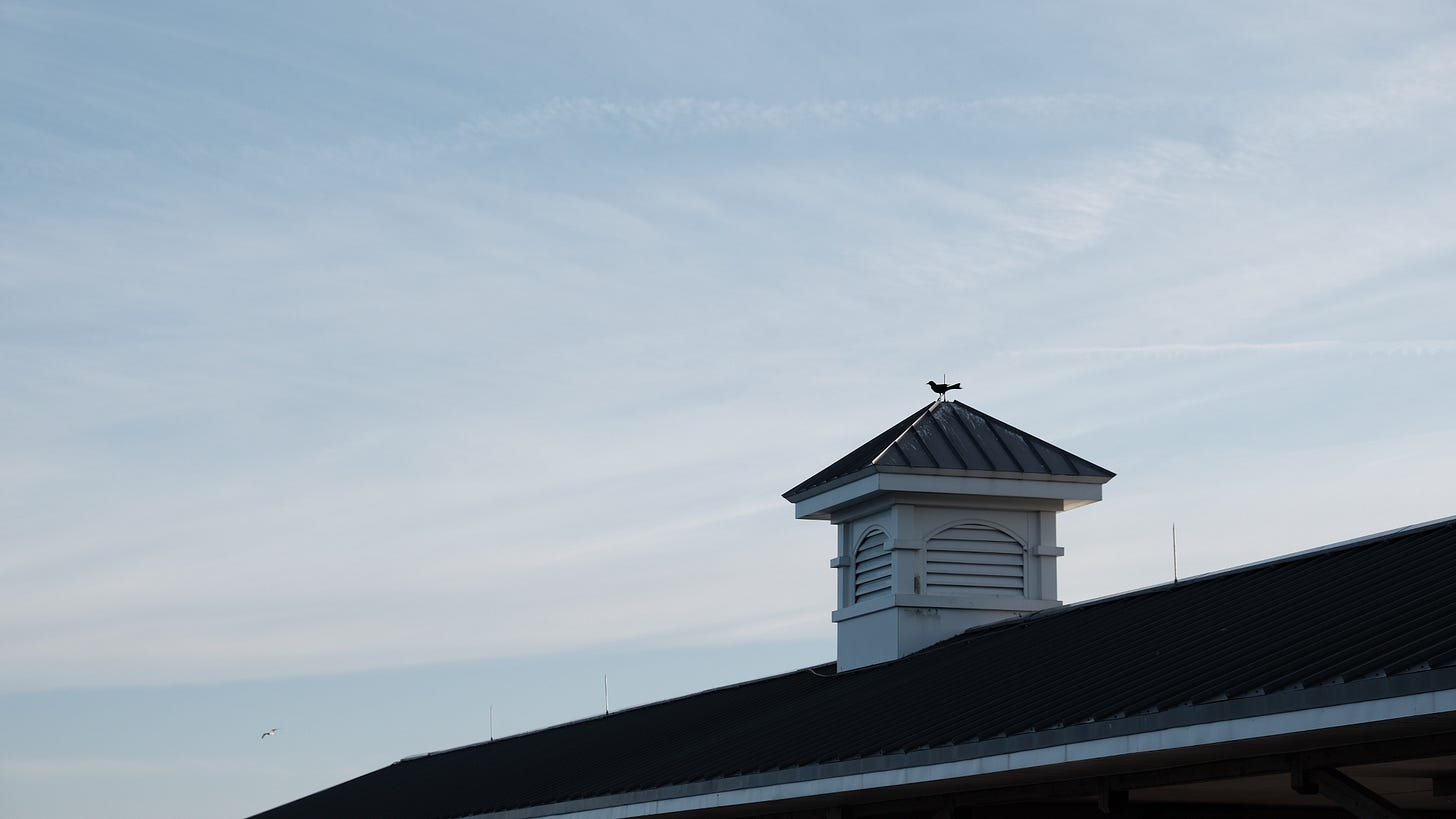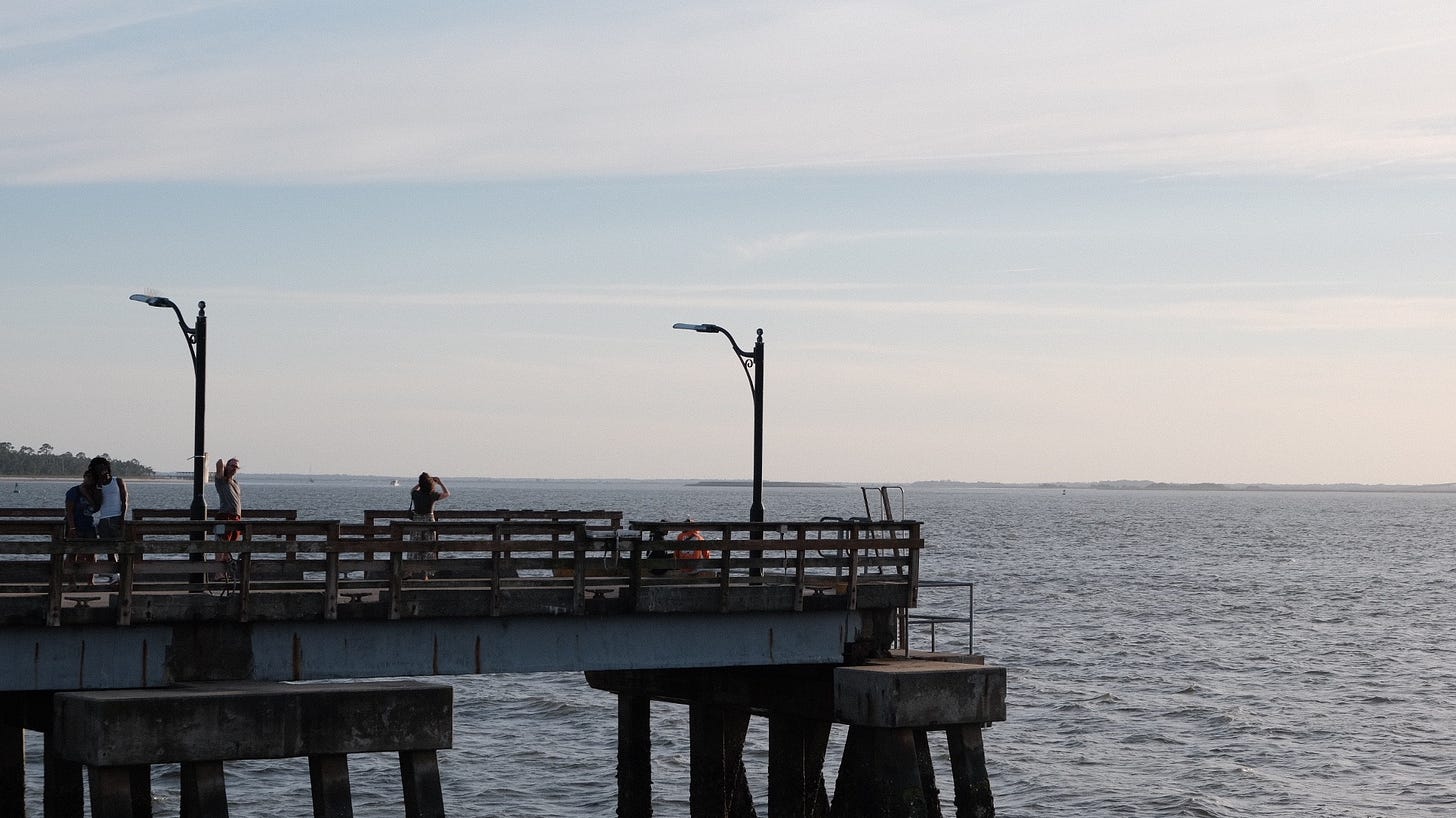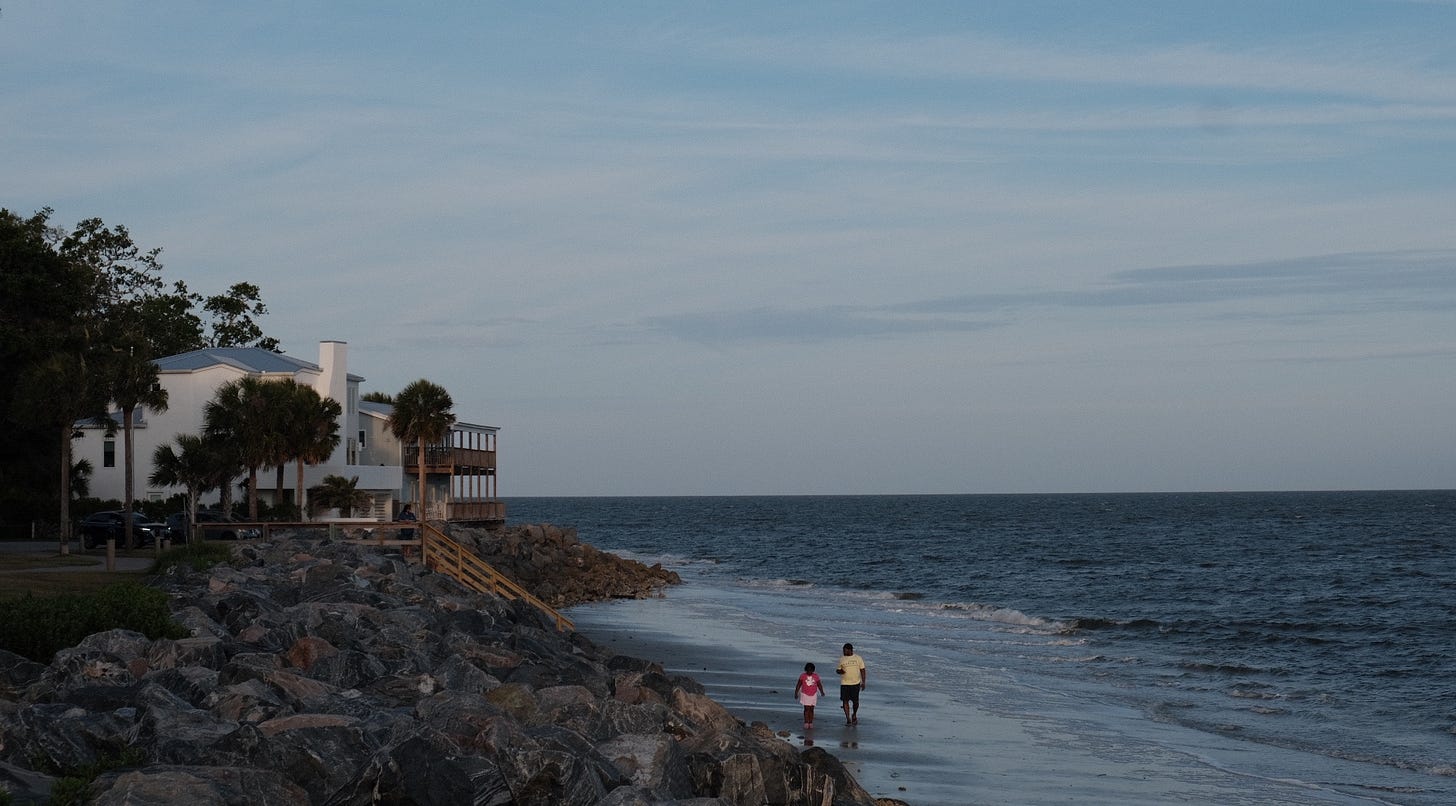"Five Vignettes About Basically the Same Thing"
What the title says. “Number three will shock you!” or something.
I’ve had a lot on my mind recently. I’ve been trying to make sense of my latest pro start, whose mediocrity has eluded notable insight. I’m trying to better balance adult responsibilities like golf and newsletter-writing with adult responsibilities like keeping my apartment neat and getting my car registration renewed. I want to do a bunch of things: get back on the drums, have an ongoing coding project again, learn to swordfight (after watching Strapped Texas), learn to knife fight (after visiting a sketchy bar in Augusta), get through the stack of books on my nightstand. I also want to hit wedges well enough to make money. And those damn fruit flies are back, and they keep getting into the fridge somehow, and it’s all-out war against the little fucks.
On Monday, a third friend independently suggested I go on a long walk, and I realized the world might be trying to tell me something. So I took only my keys, notebook, and water bottle and head out on a loop around the airport. I didn’t have a watch or any idea of how long the loop was, and it’d probably get dark while I was out there. But I’d just keep walking.
There’s a sense in which I live in St. Simons, Georgia now, and there’s a sense in which I don’t. I mostly go from my condo to the gym to the course to the Winn Dixie (or, if I’m feeling fancy, the Harris Teeter) and back to the condo. Sometimes I’ll cold plunge or shoot pool at Rafters, but it’s largely a closed loop, a smaller world than the island proper.
I’ve liked thinking my whole life. It’s no surprise why; Western society has held special reverence for rationality since the monks rediscovered Aristotle in the Middle Ages. And I’ve considered thought, generally, the same way economists considered money in the 80s: velocity is key. If I produced more thoughts than the next guy, then I’d get further in my understanding. And so I produced as many thoughts as I could, whenever I could.
At some point on a long walk, you run out of things to think about, and the walk just takes you along. Turning left out of my parking lot, I noticed an organic market I’d forgotten about, fresh produce right down the road from me. There’s a chiropractor next to the realtor that I’ll never go to. The Spanish moss hangs on some streets differently than others, and you realize why so many homes are painted white as the sun sets through the trees. It took longer than I thought to get to the pier — there’s more island along the way than I realized.
It's technically a small town, St. Simons, but a place is as small as you make it. I go about a lot of my life checking boxes and finishing tasks with my head down, not even realizing I’m stuck in there. But that’s what the walk is for, what my friends wanted for me when they told me to take one. To walk around long enough to let my mind go quiet — if you do, the rest of the world will take its turn to speak.
I’ve been putting horribly — it’d feel robotic if robots could also doubt their reads. And so I went to the Speedway, an 18-hole putting course for hotel guests. There’s big slopes and long lags, and kids run around on the turf, and it seemed as good a place as any to stop the perfectionism and get out of my head. I ran into my friend Muzzy on the way, and we agreed on a bet: 25 pushups for the loser, 10 for every three-putt. It seemed reasonable. But, after a loss and six three-putts, I knew I owed more pushups than I could do. I did 65 (good form: nose and chest to the ground, arms locked at the top), and Muzz picked up my last 20 for me — I couldn’t have done another if you gave me the rest of the day.
As it turns out, the next day was my first time playing with two-time Tour winner Michael Thompson. And, after one swing on the range, I realized I had a serious problem. The arms transfer all the power from your legs into the club, and it keeps the club squared up and on plane. If the legs are the engine, the arms are the driveshaft. But I’d blown my U-joint — my push-upped-out pecs refused to stabilize anything, and the club swung in transition like a towel over my head to signal surrender. I was barely making contact.
Standing on the first tee, Michael told me not to make fun of him: he was still recovering, and he’d do nothing more than dink driver out there. He made an easy but solid move, as Tour pros do. Following him, I — who’s built an identity on elite driving — hit a 190-yard toe hook nearly out of bounds. When we got up to the ball, we saw that Michael had outdriven me by five yards, recovering labrum and all.
Embarrassed, I reminded myself that embarrassment doesn’t do me any good, and my job as a professional was the same as it always is: figure it out. After a few holes of tinkering, I slowed my transition to a near-pause, the club floating at the top without the need to stop it with my arms. And I started hitting it better.
The arms also, under usual circumstances, make those subconscious micro-adjustments that enable pure contact. With my arms jellied, I couldn’t feel the clubface much, and I couldn’t correct it anyways. But, under the gun, the body has a strange way of adapting. By the time we made the turn, I realized I was executing all those swing feels I’d been working on for months: my right heel staying down through impact, my hands staying on plane instead of going over it. It was just happening.
Over the preceding months, I’d hit hundreds of balls and played dozens of rounds completely incapable of keeping my right heel down. Little did I know, if I just did pushups to failure, my chest hitting the putting green like Dorothy clicking her heels, the technique would come to me. Really, it was already there, was always there — I just had to give up a bit of myself first, get a bit of myself out of the way.
One of my favorite pieces of philosophical correspondence[1] began in 1643, when the Princess Elisabeth of Bohemia began exchanging letters with the French philosopher Rene Descartes. Descartes, of “I think, therefore I am” fame, made his name as the world’s most prolific doubter[2]; “Cartesian skepticism,” as it’s known, claims that it is possible even to doubt the existence of the body, that only the thinking mind is certain to exist. The line of reasoning produces a divide: the body, made of material stuff, is separated from an immaterial thinking mind.
This idea is known today as “mind-body dualism”, and it’s massively important to modern philosophy of mind. But it’s what Elisabeth of Bohemia pushes back against in her letters to Descartes. She’s confused, and she asks politely how, if the mind and body are totally separate, the mind exerts influence on the body? In reality, she’s not confused at all, and Descartes’s reply flounders and dodges the question. And Elisabeth responds with one of philosophy’s greatest Carter-over-Weis poster jams: “it seems that all the determination of motion occurs through the impulsion of the thing.” The mind and body seem to influence each other; the mind pulling a hand away from a flame when the hand tells the mind it’s in pain. If Descartes says it’s impossible for the mind and body to come into contact, why does it seem like they do?
The debate has been left for the next 400 years of physicalists and dualists to tackle. If there’s any modern consensus, it’s that mind seems to arise from matter under special conditions — physical things like brains come to have consciousness, and things like tables don’t. But this leaves each sides’ problems intact. For the dualists, if consciousness (“mind”) is non-physical, why does it only show up under certain physical circumstances? For the non-dual physicalists, how can you explain mental properties — sensations, emotions, the feeling that one has their lights on — in terms of physical properties[3]? And neither can explain: what exactly is this stuff called “mind?”
Philosophy, at its absolute best, takes seemingly obvious ideas, aligns them with rigorous logic, and produces a shocking result. The beauty of logic is that it’s a provably strong link in the chain. If you get a shocking conclusion from seemingly obvious ideas, then you only have two options: either question those initial ideas you thought were obvious, or wonder if that shocking conclusion is really true.
There’s been a third position to emerge in the mind-body discussion. Really, it’s been around far longer than physicalism or dualism, but it’s so unintuitive to western philosophy that it’s only recently entered the debate, formally so. The position is called “panpsychism,” and it asks: what if it’s all conscious? What if all physical stuff also has traces of mind? When I touch a table, is it that there’s no emergent feeling at all — that it’s just as much conscious contact as physical, that the consciousness was there all along?
It seems to solve the relevant problems: physical properties come along with mental properties because they always do; the brain being special in having consciousness is a false assumption; and mind is a part of matter, two sides of the same coin. Of course, it comes with its own set of questions — an enormous set of questions, probably larger than the ones that came before it. But is it better for physicalists and dualists to continue butting heads as they have for centuries, or should we consider an idea so wild that it might explain everything?
An intermission: some photos I took that I like.
There’s a unique value in talking shop with someone who’s won big-time golf tournaments. It’s the reason the setup at Sea Island is so valuable. In Jupiter or Scottsdale or Vegas, there’s some stratification: the Tour guys play out of the best clubs, the KFT guys out of the next best, and the rest play wherever they can. At Sea Island, Tour guys and first-year mini-tour guys practice on the same range. It’s the best place in the world to learn the game this way.
The day after we played, Michael was kind enough to come watch me hit wedges on the back range. My frustrations with wedging are just as public to my playing partners as to the readers of this newsletter, and he offered to help. I told him I was having trouble with distance control.[4] He asked if the ball was coming out of the same window on every swing, and I said it wasn’t. He informed me that I had it backwards: I needed to control my trajectory and dispersion first, and only then could I work on distance control.
If you consider golf as a physics problem, this makes sense. If the ball isn’t coming off the clubface consistently, then how are you supposed to control anything? Golf balls, in the modern game, are small aircraft; they’re launched with specific loft, speed, and spin characteristics to access small targets. If you aren’t controlling the launch conditions, then how could you ever hope to hit a target?
But, if you consider golf as a physics problem, then nothing makes sense at all. Consider, by themselves, how tight the tolerances are to launch a ball from 135 yards, have it land in a 10’ circle, and spin enough-but-not-too-much to say there. Now, consider the tolerances for delivering a club to the ball — maybe through grass or sand — to produce these conditions. And then think about the human body using all its 600 muscles and 350 joints to swing that 3-foot club within those tolerances. Not to mention some dew on the ground to take spin off, or a gust of wind to blow the ball offline once it’s already been struck. It quickly becomes an impossible problem.
I started the range session by telling Michael what I was working on mechanically; he never responded with anything mechanical. It’s not what he was trying to convey. All he wanted me to do was hit a wedge at a target he chose — without giving me a yardage — until I had the ball coming consistently out of the same window and a small pile formed on top of it.
What we’d created, he told me, is a picture. It’s a total visualization of the shot: the feeling at impact, the way the ball launches, the window it flies through, how it sits on the wind, and how it falls towards the target. A couple times, I missed poorly, and he’d ask what went wrong, and I’d say I failed in some technical aspect of my golf swing. He told me that was incorrect. The only difference was that I wasn’t as committed to the shot as I was on the previous ones — that some part of the picture was missing. Professional golfers are not professional golf-swing-makers; they’re professional visualizers. The swing only ever works when it’s serving the visual. Trying to affect the swing itself to produce a result is like flying a plane by instruments: really hard. And golf’s too hard a problem to solve without looking out the windshield.
When I thanked him, I told him that I hadn’t thought about golf like that in a long time — that I’d been too caught up in technique and launch-monitor numbers and proximity stats. But, again, I was wrong. I played in college, he told me, and I was a professional golfer now. There was no way to get to this level without that visualization, that way we paint the scene in our mind’s eye. I’m right to think that golf is an impossible problem, from a physics standpoint. And so there’s no way to have any success — even the comparatively meager success I’ve had — without being able to conjure a little magic. To paint that shot in our mind, wave the club like a wand, and make it appear.
I’ve always been a believer that I’m playing golf for a reason beyond golf, that it tends towards some greater personal betterment. And, while I’ve been here, I’ve met people who understand how to optimize general human performance. For whatever reason, be it disorganization or that general young-adult figuring-out, I’ve been waking up tired even when I get good sleep, and it takes a little bit to get the engine turning. And so I asked my contrast-therapy guru to ask his contrast-therapy guru about a morning routine: the best way to get myself firing in the ten minutes after the alarm goes off.
In detailing my contrast therapy experience in Slick’s Garage, I said that Paresh’s carrots started talking to me. While this doesn’t feel wrong to say, I guess it’s not entirely right either. It’s not that I hallucinated the carrots pulling themselves out of the ground and singing to me, holding hands and dancing in circles. They stayed put, as you could find them now, their stalks slowly drifting in a breeze.
In reality, as the DMT made my concept of my independent self foggier, I had a realization that was profound to experience and silly to say out loud: that the carrots and I both come from the Earth and will return to it, just the way we are, and there’s no reason to be insecure about anything that’s just our own nature. Because that’s the way everything is: just itself as part of the world, inseparable from the world that birthed it and accepts it the way it is. The obvious interpretation might be that I had these realizations, as myself, but I don’t think that’s true. I think I received this realization from the carrots, or from the larger world that holds both of us. That’s why I said they talked to me — I do believe that’s genuinely what happened.
Talking with Michael, I’d mentioned putting as well as wedging. As I talked, I realized he didn’t need any more information; he already knew what I needed to hear. Go make 100 three-footers in a row. Each one, try to make it in the dead center of the cup with perfect pace. If you miss a putt, you go back to 1. Eventually, the picture is going to get clear in your head, and nothing else is going to matter, and a lot of putts are going to go in.
And so I did. I stuck a tee in the back of the hole to visualize my target: just barely kissing the tee on the way in. The first couple putts felt as balky as ever, and, of the first five, I thought I missed at least two, one big push and one big pull. When I looked up, they hit the left and right sides of the tee and dropped into the center. By putt 30, I realized my stroke was fine, that I was rolling the ball end over end. By putt 60, I realized that the stroke didn’t matter at all, that the ball did nothing more than roll in service to the picture. On the last ten putts, I thought about how much it would suck to miss one and have to start over. On the last five, I realized I wouldn’t have to, that they’d all just go in. And then the hundredth putt fell in and I was done.
There’s an old saying that “enlightenment is always an accident,” that it’s not something we can do — all we can do is cultivate some degree of being accident prone. I don’t think I’ve had any true accidents — the closest I’ve gotten was the carrots. But I think I’ve slipped that direction a couple times. Moments when I haven’t had much on my mind, when things get a bit stiller and it all starts to clarify.
On that walk, the long one around the airport, by the time I’d passed the pier and headed home as it started getting dark, I’d run out of things to think about. At this point, I had four realizations right in a row.
That no perfect person has ever won a golf tournament, so I should stop trying to become one;
That most people don’t have their lives figured out at 24 — that, no matter their accomplishments later on, most people’s Wikipedia biography to this point is just titled “Early Life”;
That I want to scale the mountain and win Tour events, to be someone capable of overcoming whatever needs to be overcome — but that I’m not sure what I intend to do with this power when I achieve it;
And that I just love golf, and that’s all I really need to worry about right now.
And then I got home.
Every morning since that walk, I’ve made my bed, put on shorts, filled a bottle with water and electrolytes, and gone out on my balcony. Prior to this week, I’d been out there maybe twice. But I went to Ace Hardware on Sunday and got a $35 camping chair and set it up on the balcony. It looks NNE, and I drink my water and watch the sun rise over my neighbor’s house, taking in the sunlight coming through the trees and shining off the aluminum roof. Usually their sprinkler system is running. There’s ample birdsong. The leaves drift on the breeze. There’s a door between me and the fruit flies and the rest of the day. As I get my body back to 70% water after a night asleep, I feel I’m doing something similar to my mind, feeding it something good to start the day. Although, I don’t think that’s quite right: really, I’m just reminding it of the rest of the world and getting it in touch with what it’s always been.
[1] I love saying things like this — it makes it seem like I spent my life developing a massive stockpile of philosophical correspondences, like I’m the most well-read guy out there. I was, effectively, a philosophy student for 2.5 years of a 4-year degree. This particular correspondence is one of my favorites because I’m pretty sure it’s the only one I’m familiar with. It’s misleading, but what a thrill!, so I’m going to keep doing it.
[2] At least until Hume came along ~70 years later and doubted whether the sun would rise tomorrow. Consider them the Jack and Tiger of philosophical doubt.
[3] If you’re interested here, or if you think you think it’s a silly question (“feelings happen in the brain! from neurons!”), then please look into David Chalmers’s “hard problem of consciousness. I think this video explains it nicely:
You can also listen to his TED talk:
The main vector: why, when my brain does something (touching something hot), is it accompanied by not just a stimulus response (moving my hand away to avoid damage) but a conscious experience of that event (feeling pain)?
[4] Which is, like, literally the only relevant thing in wedging — it’s like saying I’m having trouble driving a car and I’m working on turning the steering wheel.






